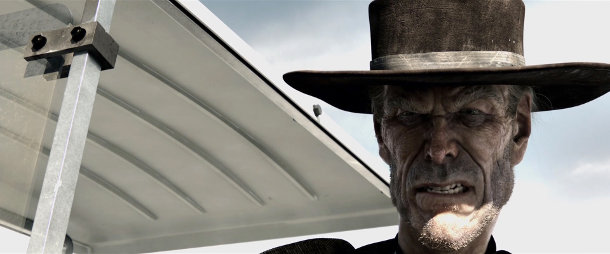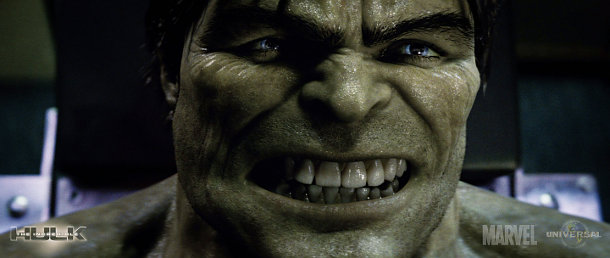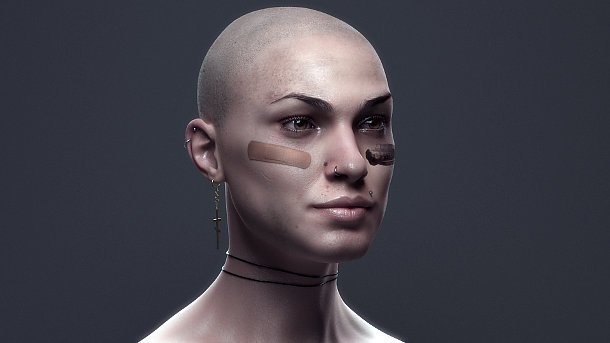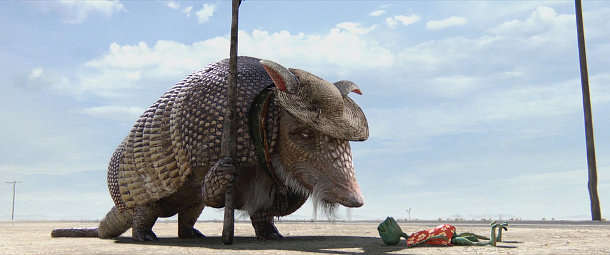Q&A: Rango and Hulk texture painter Justin Holt
 Justin Holt’s new Gnomon DVD distils his experiences on movie creatures into practical Mari 2.0 painting techniques. In this Q&A, he discusses his workflow and his tips for great texture work.
Justin Holt’s new Gnomon DVD distils his experiences on movie creatures into practical Mari 2.0 painting techniques. In this Q&A, he discusses his workflow and his tips for great texture work.
In the case of Justin Holt, medicine’s loss is art’s gain. Now one of the world’s leading texture painters, with a reel that includes Watchmen and The Incredible Hulk, he originally enrolled at Virginia’s James Madison Unversity with the intention of becoming a doctor.
A switch from pre-med to art brought Justin into contact with LightWave, but it wasn’t until his brother, a student at Savannah College of Art and Design, suggested that he transfer there to pursue VFX for films that “everything fell into place mentally”.
After graduation, Justin worked for leading VFX studios including Rhythm & Hues, MPC Vancouver and Industrial Light & Magic. It was at ILM that he acted as Lead ViewPainter on what is perhaps the most visible public demonstration of his skills to date: Rango – the studio’s first CG animated feature, and the latest in its long list of Academy Award-winning projects.
Today, Justin balances both sides of his training, blending a passion for art with an analytical approach to texturing problems. The two are in evidence in Painting Realistic Skin in Mari 2.0, his new Gnomon DVD.
In it, Justin explores how the new features of Mari 2.0, released this week, can help to make texture painting a more creative experience, and sets out his workflows for recreating detailed, believable human skin.
We caught up with Justin to discuss his career, his advice to aspiring texture painters – and just what it is about Mari that makes it such a powerful weapon in an artist’s arsenal.

Rango’s Spirit of the West is both a nod to Clint Eastwood and the character that Justin Holt feels best embodies his fascination with the challenge of texturing human skin. Rango images courtesy of ILM/Paramount Pictures.
CG Channel: You worked on a lot of well-known characters in your time at Rhythm & Hues, MPC and ILM. Which one says most about you as an artist?
Justin Holt: That’s a tough one. But I’ve always enjoyed painting skin, so I’d have to say it would be a tie between The Incredible Hulk and Spirit of the West from Rango.
Human skin is one of the most difficult organic materials to paint, and the techniques are constantly evolving, which makes it that much more exciting. Skin shaders are constantly improving, which enables texture painters to get more creative with the types of maps they paint.
I think the joy of painting skin also stems back to my pre-med roots: the physiology of skin is fascinating!
CGC: Many people will know your work on Rango. But what have you been up to since leaving ILM in 2010?
JH: I worked briefly at Digital Domain SF on Jack the Giant Slayer, then migrated back up to The Great White North to Image Engine to build a texture pipeline in order to accommodate the work needed for Neill Blomkamp’s Elysium. I tested the pipeline on a small amount of work for Battleship and Twilight: Breaking Dawn – Part 1 before work on Elysium ramped up.
I’ve also supervised, or am supervising, the texture work on R.I.P.D., Zero Dark Thirty, Fast & Furious 6, Now You See Me and Lone Survivor.

It’s now easy being green: improvements in shader technology enable texture painters to get more creative with the maps they paint, Justin believes. Incredible Hulk image courtesy of Marvel, Universal and Rhythm & Hues.
CGC: Let’s talk about Mari. What was your initial reaction when you first encountered the software?
JH: It’s funny, but I hated it. There was no Save As option, no perceivable layering system… it was a jungle. The workflow was drastically different to what I was accustomed to. I’d also been tasked to learn it, in order to figure out how to build a pipeline around it, so that, combined with my apprehension, didn’t make for the best of first impressions.
But I also knew it was a program that was definitely going to lead the way for my discipline. Once I figured out how it worked (which actually wasn’t too difficult), I fell in love with the program and haven’t looked back.
CGC: So what was it about the software that won you round?
JH: Mari allows you to work with much heavier assets than other 3D paint packages, as well as work on exponentially larger amounts of texture data. I have worked on an asset in Mari that had over 850 4K tiles for just the color maps. The program is a beast.
CGC: How are you using it in your pipeline at Image Engine? Does it replace Photoshop?
JH: No. We still use Photoshop for grading images and creating tileable textures. I refuse to restrict my texture painters to obtuse workflows, so I have some painters on my team who employ a Nuke and Mari workflow, others who just use Mari exclusively and others who use Photoshop and Mari together.
As long as the final textures look good, I don’t care which approach they take. I firmly believe that creative freedom breeds happier artists – and better work.
CGC: So what’s the key benefit of Mari in day-to-day work?
JH: Not having to manage hundreds of textures manually. Mari handles this beautifully.
CGC: You’ve said that when you learned your craft, Paul Campion’s Gnomon DVDs were a key resource. What was it about them that inspired you?
JH: What interested me in was how methodical and precise Paul was in his approach. There was a strong element of deductive reasoning that I immediately was drawn to. I enjoyed the way he pragmatically deconstructed surfaces and his methods in slowly but surely building them back up.
CGC: How have they shaped your own approach to recording tutorials?
JH: Another fantastic thing about Paul’s DVDs was the fact that he talked about what he was doing at the same time as recording the tutorials. The fact that everything played in real time made it incredibly easy to learn from.
I know that some other titles approach it differently, first recording the physical work and then laying down an audio commentary in post, speeding up playback of the work significantly. I always felt I couldn’t learn anything from that method, and was insistent on recording my DVDs in the exact same manner as Paul’s.
CGC: So what will you be covering in your new Gnomon Workshop DVD?
JH: I’ll be looking at the process of texturing a character, beginning by gathering and grading texture references and moving through the process of painting color maps in stages: epidermal, subdermal and deep tissue.
Then I move on to painting base and wet specular maps, fine displacement maps, and techniques for weathering skin and painting eyes. Along the way, I’ll be introducing viewers to the new features in Mari 2.0.

Painting Realistic Skin in Mari 2.0 explores techniques for texturing human skin, including painting color maps in dermal layers, the distinction between base and wet specular maps, and tricks for painting convincing eyes.
CGC: Which features of Mari 2.0 will you be using?
JH: Besides generally getting people up to speed with the release, the most significant new feature I will be covering is the new layer system, masking features and adjustment stacks.
CGC: Features of a type that people will be familiar with from Photoshop, then. How do they help Mari users?
JH: Offering a large range of creative techniques allows us to make the best possible textures we can. Artists, especially texture painters, want to be able to focus on the art and not the file management or technical quicksand other disciplines can find themselves in.
CGC: Do they enable you to do anything you couldn’t have done in Mari before?
JH: Most definitely. I’ve said this before: Mari allows you to paint in the context of an asset in a way digital texture painters never have been offered before.
Historically, we have had to rely on the constant back-and-forth between two packages in order to paint. Not only was it a time-consuming hassle: it also stifled the creative process. Now we can make creative decisions organically, on the fly, much in the way of the practical painters working on real sculpts and props.
CGC: Will you be showing the viewers any cool technical tricks?
JH: I’ll be running through some neat ways to use masks to maintain a non-destructive workflow, painting color maps independently of your displacement maps, and using the layer system and adjustment stacks to build up complexity in your textures. You’ll have to watch the video to find out more!
CGC: And what’s the single most important idea you want to get across in the tutorial?
JH: Don’t be afraid to experiment. Try new things, explore and have fun!

What doesn’t kill you makes you stronger: don’t be afraid to experiment, advises Justin. It’s only by embracing change – and the need to continually reassess your workflow – that you become a better texture artist.
CGC: You’ve said that you treat texture painting like deciphering a visual puzzle. How does that affect the way you work?
JH: It allows me to maintain a non-destructive workflow, as well as not becoming a slave to texture reference that, more often than not, isn’t ideal. It also allows me to have full control over every attribute of the textures so I can create more complex secondary maps.
Photo reference shot properly from set sometimes works, but there is a lot of manual painting to build proper layers in order to manipulate the photos correctly.
CGC: What separates the work of a truly great texture artist from a good one?
JH: Knowing what to add or leave out in order to achieve a photorealistic result. The devil is in the details, and the greatest texture painters I’ve worked with are masters of details that promote the overall look of the textures.
Too many painters focus too much on every detail or too much on the broad strokes, and forget the key to success is the balance of both.
CGC: What kinds of details are we talking about here?
JH: Details that we take for granted: things we see on an everyday basis and don’t acknowledge consciously because of the frequency with which we see them. It’s true of hard-surface assets, but even more so of organic characters. For humans, there are so many more variables when deciding what details to put into paint.
One example is the brightness of the scleras of the eyes. A common mistake is to make them white: in reality, they are generally about the same intensity as the skin. Making them too bright brings them into the Pixar realm.
CGC: Artists see characters close-up for long periods of time. Are those kinds of fine details really visible to viewers if they only see characters briefly, and in motion?
JH: Maybe not consciously, but a slight oversight in this takes you out of the illusion. The average person knows that a character doesn’t look real, even if they don’t necessarily know why.
Without question, making great textures does take time. You need to build up the paint before the textures start looking great, especially for skin. Too often artists stop early on skin painting, and don’t spend time on that final 5% to bring the character into the realm of the unique and the photoreal.
CGC: What’s the best tip you could give to someone who aspires to this level of work?
JH: Stay humble, embrace change and constantly move towards bettering yourself as an artist.
Be open to learning from everyone around you, from the juniors to the seniors. There is always something new to learn. As one of my favorite quotes from Walt Disney goes:
“Around here, however, we don’t look backwards for very long. We keep moving forward, opening up new doors and doing new things, because we’re curious… and curiosity keeps leading us down new paths.”
Painting Realistic Skin in Mari 2.0 is available now from The Gnomon Workshop’s online store on DVD or digital download, price $79.
Buy Painting Realistic Skin in Mari 2.0 from the online store
Full disclosure: CG Channel is owned by the Gnomon School of Visual Effects.
